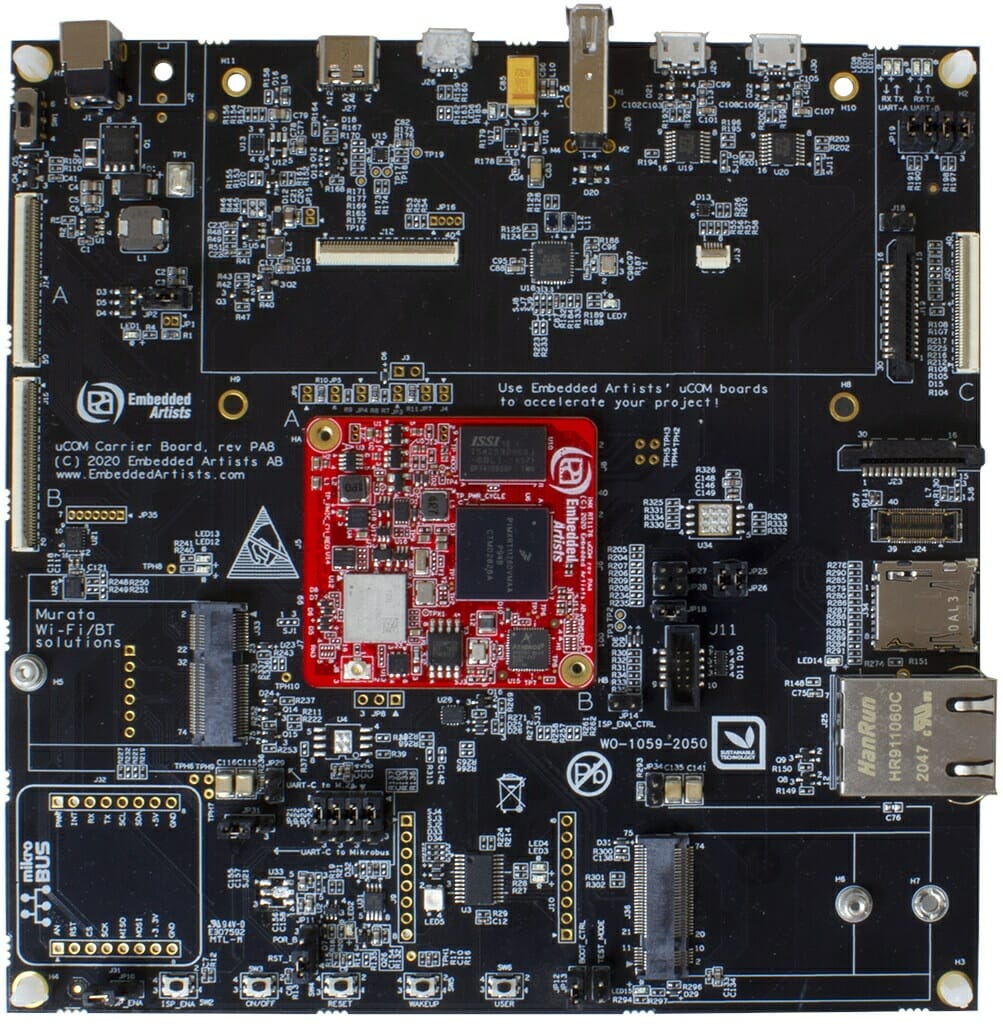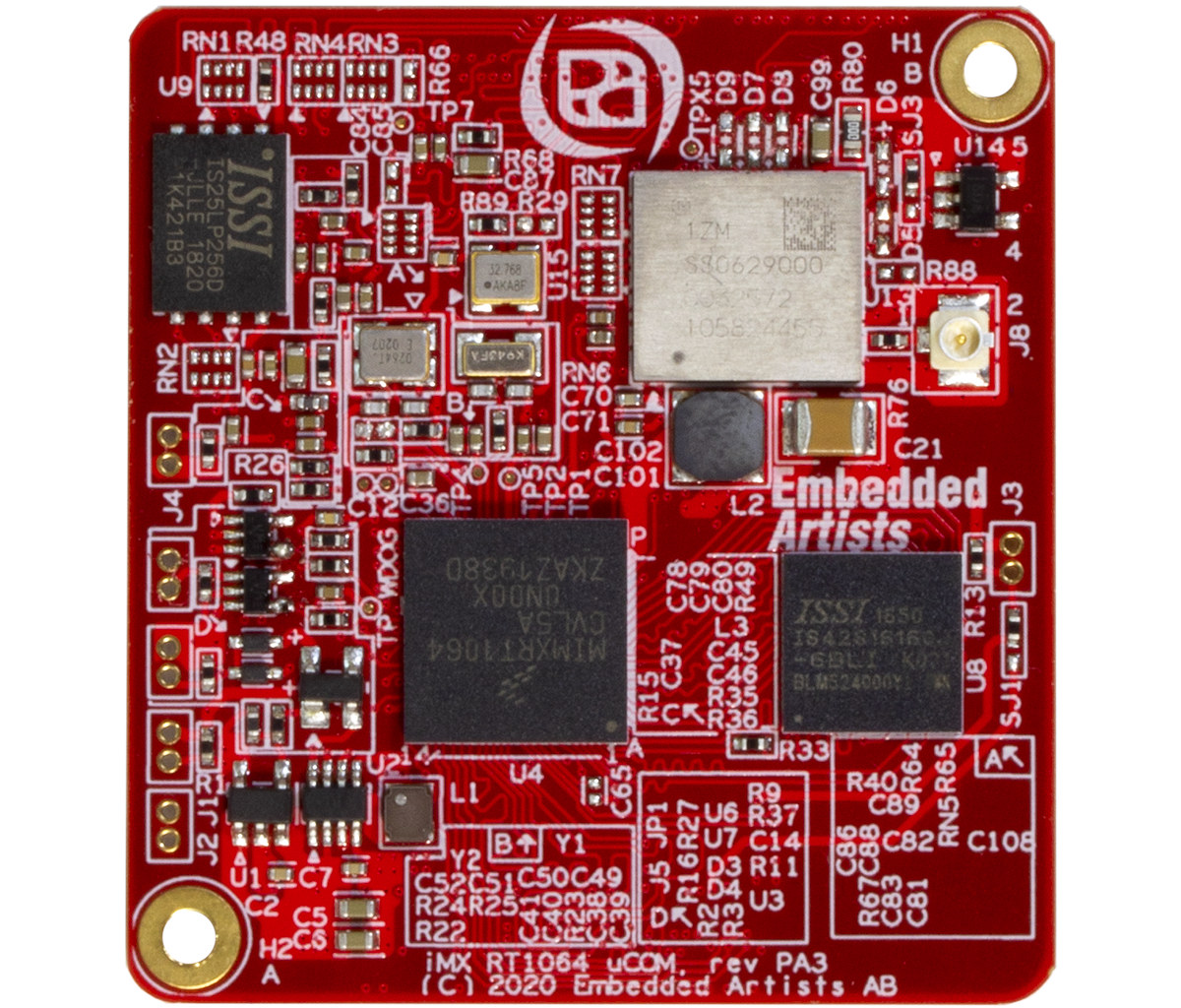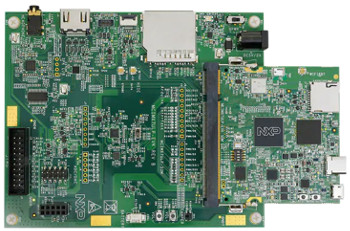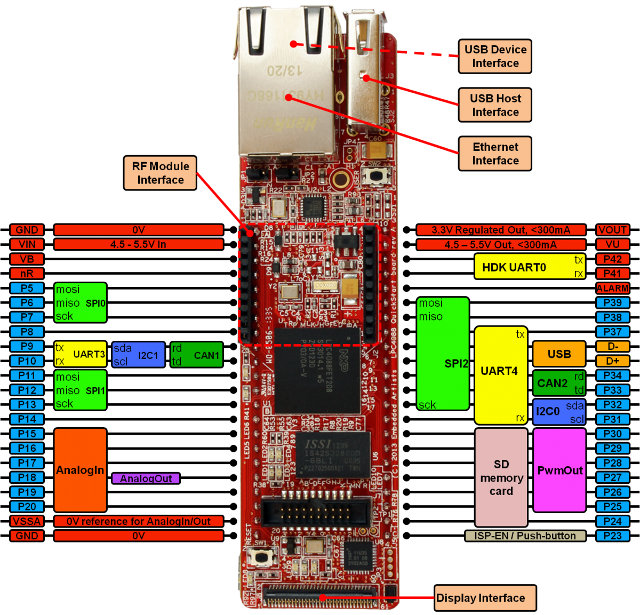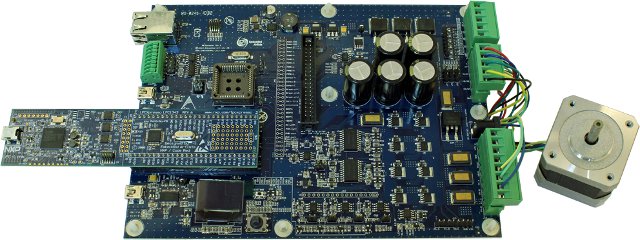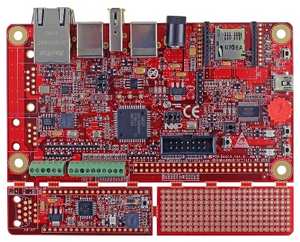Microcontrollers used to be those cute little chips clocked at 8 MHz, but it’s now common to have MCUs clocked at one or two hundred Megahertz, and with Cortex-M7 cores, several hundred Megahertz is now possible, and NXP even pushed the limit to one Gigahertz with their i.MX RT1170 series of Cortex-M7/M4 Crossover MCUs announced over a year ago. Embedded Artists has now made a computer-on-module and a corresponding devkit based on NXP i.MX 1176 Crossover MCU clocked at one Gigahertz. iMX RT1176 uCOM MCU module delivers up to 6468 Coremarks, comes with up to 32MB SDRAM, 16MB QSPI flash, optional WiFi and Bluetooth, and various peripherals in a tiny 45x42mm form factor. iMX RT1176 uCOM module Specifications: SoC – NXP i.MX RT1176 processor with Cortex-M7 core up to 1 GHz/800MHz (Commercial vs industrial), Cortex-M4 core up to 400/200 MHz, 2MB internal SRAM, 2D GPU with OpenVG 1.1 support and […]
Embedded Artists Unveils iMX RT1064 uCOM with WiFi 5 & Bluetooth 5.1 Module
Embedded Artists have recently introduced iMX RT1064 uCOM system-on-module powered by NXP i.MX RT1064 Cortex-M7 crossover MCU clocked at 600 MHz with 1MB SRAM and 4GB flash on-chip, as well as 32MB SDRAM, and equipped with an optional WiFI 5 and Bluetooth 5.1 module from Murata. iMX RT1064 uCOM technical specifications: SoC – NXP i.MX RT1064 Arm Cortex-M7 @ up to 600 MHz with 1MB SRAM, 4MB on-chip QSPI flash, 2D graphics acceleration engine System Memory – 32 MB SDRAM Storage – Optional additional 4GB to 32GB eMMC flash and/or SQPI flash Wireless – Optional Murata Type 1ZM dual-band 802.11b/g/n/ac WiFi 5 and Bluetooth 5.1 module based on NXP 88W8987 2x DF40C-100 board-to-board connectors: Storage – 2x USDHC Display I/F – 24-bit parallel RGB up to 1366 x 768 pixels Camera – Parallel CSI Audio – 3x SAI, SPDIF Connectivity – 10/100M Ethernet (requires PHY on carrier board) USB – […]
NXP i.MX 7ULP Enters Mass-Production, EVK and Systems-on-Module Announced
Last year, we wrote about F&S Elektronik Systeme PicoCORE MX7 system-on-module (SoM) powered by NXP i.MX 7ULP processor manufactured with a 28nm FD-SOI process, and that was announced a year earlier. The official launch of the module was planned for Q3 2018, but there have been some delays as LinuxGizmos reports NXP has only started mass production of their i.MX7 ULP this June. With the official launch of i.MX 7ULP, the company also introduced the official i.MX 7ULP Evaluation Board (MCIMX7ULP-EVK) as showcased on Element14’s community and several other companies announced i.MX 7ULP systems-on-modules. Benefits of NXP i.MX 7ULP Processor The i.MX7 ULP family of processors is an extremely power-efficient series, that is utilizing lower power for more functions. The SoC is being touted as the most power-efficient processor that can be obtained that also houses a 3D GPU. Although like the i.MX7, the i.MX 7ULP combines both Cortex-A7 and […]
ARM Unveils Embedded Systems Education Kit Based on NXP LPC4088 Cortex M4 MCU
Following up on their first “Lab-In-a-Box” initiative based on Micro STM32F4-Discovery board and Wolfson audio card, ARM launched another low-cost toolkit, based on Embedded Artists LPC4088 QuickStart and Experiment boards, and called “Embedded Systems Education Kit”, to help university educators teach embedded systems design and programming concepts. The kit includes the following hardware, software tools, and teaching materials: Embedded Artists LPC4088 QuickStart Board and LPC4088 Experiment Base Board ARM Keil MDK-ARM Pro microcontroller development suite software licences Complete teaching materials including lecture note slides, demonstration code and hands-on lab manuals with solutions in source for four embedded system courses: ‘Efficient embedded systems design and programming’ teaches microcontroller fundamentals using NXP’s 32-bit ARM Cortex-M4 based LPC4088 microcontroller. ‘Rapid embedded system design and programming’ delivers embedded systems design training for the high-level ARM mbed API ‘OS design’ uses the royalty-free ARM Keil RTX RTOS to show how to design, program and optimize […]
Embedded Artists NXP LPCXpresso Motor Control Kit Promotion
Embedded Artist and NXP have jointly designed the LPCXpresso Motor Control Kit to easily get started with motor control prototyping. This platform is based on NXP LPCXpresso MCUs and can control BLDC (Brushless DC), BLAC (Brushless AC), stepper and dual brushed DC motors. This is not a new design (2010), but Embedded Artist and NXP are discounting their development kit by 50% for a limited period, which brings the price of the kit to 149 Euros, instead of 299 Euros. The kit includes: LPCXpresso Motor Control Board LPCXpresso LPC1114 Board (The “stick” on the left in the picture above) LPCXpresso Eclipse-based IDE and GNU compiler BLDC Motor with hall sensors 24V Power supply (60W) Here are the specifications of the Motor Control Board: Controller MCU • Socket for LPCXpresso LPC1114 and LPC1343 • Socket for LPCXpresso LPC176x • Socket for LPC1xxx in PLCC44 • Expansion connector for control by LPC1800/LPC4000/LPC2900 […]
Embedded Artists and NXP Release The First ARM Cortex-M Android Open Accessory Development Kit
Embedded Artists and NXP introduced the TN-20764, a board that can be used with Android Open Accessory Application (AOAA) development kit that features 2 NXP Cortex-M MCUs, at Embedded World 2012. The board includes Ethernet, CAN and IEEE 802.15.4 interfaces as well as a remote CAN node, enabling designers to develop accessories for consumer applications, as well as home, building and industrial automation applications requiring different types of connectivity. There are already Arduino and PIC-based Android Open Accessories, but this board is the first AOAA kit based on ARM Cortex-M micro-controllers. As mentioned above, the board features 2 Cortex M micro-controllers: The NXP LPC1769, a 120-MHz Cortex-M3 based MCU, provides the interface to the Android mobile device via its full-speed USB transceiver . The LPC1769 also includes 512 KB flash and 64 KB on-chip SRAM, an Ethernet MAC, a CAN 2.0B controller, an 8-channel, a 12-bit ADC, a 10-bit DAC, […]


